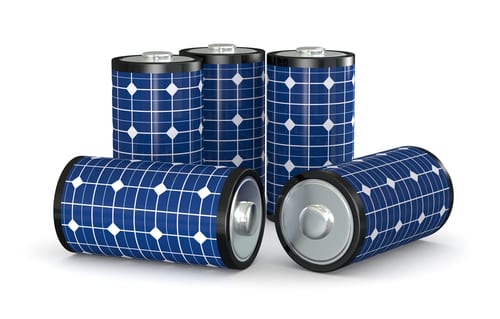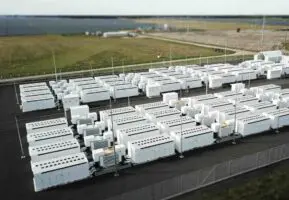AGL Energy may well have fast-tracked the announcement of its first battery storage products to coincide with the ground-breaking news about the Tesla Powerwall in late April, but despite all the excitement about the falling costs of battery storage, AGL Energy does not see a mass market uptake until the 2020s.
In an interview with RenewEconomy on Friday, following the company’s two-day presentation to analysts and investors earlier in the week, the head of the company’s newly established New Energy division, Marc England, said battery storage would remain the province of early adopters for the next few years.

In the interview – you can read the full transcript here – England said rooftop solar was just one of a suite of technologies that would transform the way households and businesses would use energy.
So along with battery storage, that meant electric vehicles, home energy management systems, and even software that would allow households to aggregate their output and sell it to the grid, and a whole bunch of other interesting things.
But England says people are getting a little too excited about the prospects of battery storage. There has been big debate about what value battery storage offers in Australia, with analysts at UBS and Morgan Stanley both suggesting paybacks could be as low as six years.
“Our view is that the payback period for storage is still going to be fairly high,” England says. “It will take time before it gets under 10 years. So it will remain an early adopter product for next couple of years.”
He suggests that while energy storage costs may come down quickly, as they did with solar, two key elements that underpinned the solar boom that led to 1.4 million Australian putting solar on their rooftops are missing from the battery storage market: government incentives and rising electricity prices.
“There are no sign of government incentives to drive it,” England says. “Most predictions are that electricity prices won’t increase. We need to temper our excitement. We are excited at AGL too, but we temper that with some of the fundamentals.”
AGL Energy will roll out its first battery storage products in Queensland this month, with equipment from AU Optronics of Taiwan. NSW and Victoria will follow in coming months, although England points out that not quite as many battery storage companies are ready to roll out in Australia as some may think.
England says there is no doubt that Tesla has had an impact on the market, bringing its weight as a powerful consumer brand, but it was not yet clear if the product was suitable for the Australian market.
England also rejected the idea that the new energy division was competing with existing assets, which include the massive coal-fired generators such as Loy Yang A in Victoria, and the Bayswater and Liddell plants in NSW, along with a range of gas assets and the existing retail business.
Analysts last week welcomed the changes announced by new managing director Andrew Vesey, even though they said it was not clear if retailers such as AGL Energy would win out in the new energy economy, or other players – existing or new.
Still, as Morgan Stanley’s Rob Koh said, it was better to cannibalise than to be consumed. Large utilities such as E.ON have decided that the conflict is so great that it needs to split its business into two.
England disagrees: “I don’t actually see it as competing with the core energy business, I see it as underpinning the value in the growth in that business.
“Some commentators say that some of the technologies such as solar reduce demand on the grid, which is true. But it’s not just about solar, it’s about integrating various technologies, from solar, to storage, to meters, and bringing in home energy management and other control systems as well.”
England also rejects the idea that it was a case of incumbents versus new technologies, or the grid versus distributed energy. “It’s a very binary way some people look at this, one or the other. I see it as both. We are heading for very different future where grid is still important, and distributed sources of energy is very important.”
If the amount of solar panels were trebled, he adds, that would still equate to just 6 per cent of demand.
“So the grid is not going away. The need for low-cost generation is not going away for AGL. What we need to do is to make sure can can offer customers choice. They can get it from the grid, they can get it from their roof, they can get it from their generators … I don’t buy into this grid vs distributed. I think it is both and that is where we are heading with AGL.”
England has been set a bunch of key metrics, which include $400 million of revenue by 2020 and break-even in the newly established division by 2018. He intends to try to achieve this by installing some 400MW of solar on the rooftops of homes and businesses by 2020, and connecting 1 million of its customers to “smart devices”, be they solar panels, electric vehicles, battery storage or smart meters.
But while England concedes that AGL has started slowly with solar, it sees a couple of ways that it might be able to claw back some of its missing share.
One of those is with monitoring technologies that provide analytics on the performance of solar arrays. It estimates that up to 25 per cent of existing installations are under performing – due to poor installation, faulty inverters, shading, dirt, or just ageing modules. Most customers do not even know this.
AGL is getting together with a technology “start-up” to provide analytics to its own consumers and to others. It is also looking at technology that will allow it to aggregate the output of solar households and trade it on the national electricity market.
He says this is just one part of the technologies that will come into homes and businesses, provide the ability to create virtual networks and link them together perhaps with demand response technologies, virtual power plants, batteries, and allow consumers to share power.
“That is the future … that is where we are heading,” England says. “It comes back to consumers wanting choice, they want to engage in energy. Some will want to have comfort, some will want convenience, some will want more control.”











